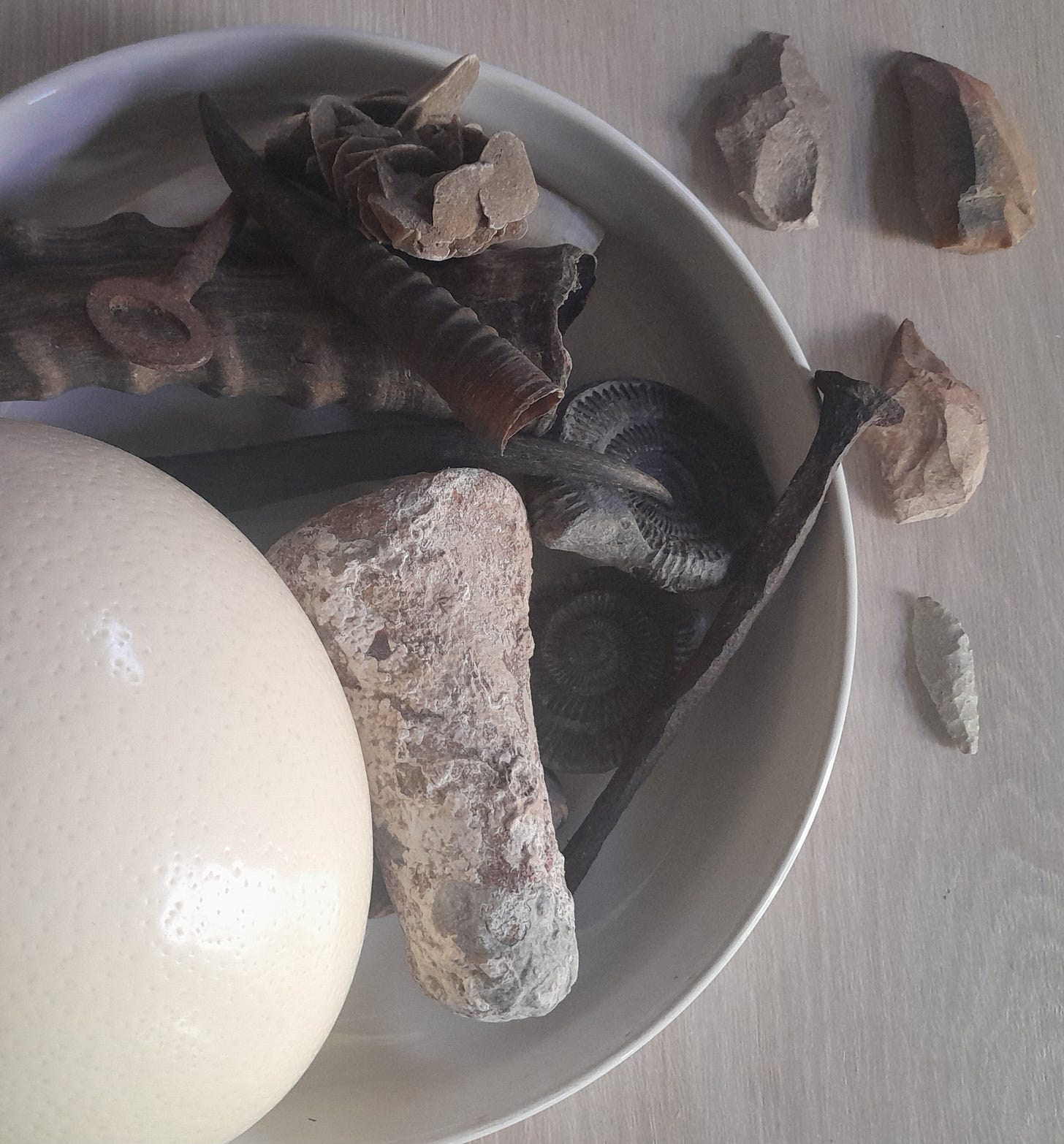Where do you start with a memoir? I was asked this out of the proverbial blue the other day. It’s a good question and as it coincided with a burst of home maintenance, the answer came while I was moving things that were in the way of the renovators. And the answer was stone age tools. You begin with stone age tools.
Well, sort of, certainly I could.
You see, a bowl containing those essential oddments (those oddments that all homes have in various forms) had to be moved to a safe haven. This bowl is filled with an ostrich egg, ammonites, bits of ancient Greek and local pottery, a bontebok horn, two steenbokkie horns, a rusty 20-centimetre nail, some old keys, and four stone tools. Those in the picture next to the bowl. It seemed to me, as I picked out the four stone tools, that they had been with me most of my life and in them resided a personal story. If I was going to write a memoir, I might start with those four pieces of stone.
These were found on the Fish Hoek sand dunes - when there were still sand dunes as they have long gone under alien vegetation and housing - in the first part of the 1960s. In another life I might have been an archaeologist but things didn’t work out that way. Anyhow, I have always been fascinated by what it must have been like to live in that distant past.
On the slope of one of the dunes was a midden: there, among the scattering of mussel shells, limpets shells, the remains of any edible seafood, you could find ostrich eggshell beads, chunks of pottery, stone implements. The side of that dune must have been in use as a rubbish dump for a goodly while because the shells were plentiful. I spent many hours there fossicking among what others had discarded hundreds (thousands?) of years ago.
The awl and the larger of the ‘’spear heads” come from that site. I was in awe of anyone who could fashion anything meaningful out of a piece of stone. The smaller “arrow head” I think I found at one of the other middens that had clearly been a kind of workshop for fashioning stone tools. There were stone chips and discarded half-finished tools all over the place. That too has long disappeared under bush.
The fourth colourful stone - the scraper - comes from Peers Cave. The cave has apparently been occupied on and off over the last 200 000 years, and it has some of the most southerly rock paintings in the Cape. It’s now used by some religious group who do a lot of drumming. There have also been a number of muggings on the paths leading to the cave.
But back in the 1960s, it was a quiet place and I spent hours sifting through the dark soil which was where I found the scraper. When the dirt was washed off there was this implement with its rich colouring. It was not the sort of treasure I could let go.
And I didn’t. These stones have been with me ever since. It was also because of these stones that I found my way to non-fiction books. I would read anything to do with the stone age and any memoirs by those who went digging for signs of early human life. So you see, stones and memoirs have a connection. (There is more to the story regarding the stones and the sand dunes but that’s for another time.)
Of course, the point is that the strange things we collect can be the stuff of a life story, or, at least, a starting point.
Which brings me to the memoir workshop I’ll be running at The Retreat at Groenfontein near Calitzdorp from 1 - 6 July. If you’re contemplating a memoir, family history, travelogue, autobiography, biography, chronicle, essay, confession, call it what you will, join my four-day life-writing course to learn how to develop your story.
The all-in cost (workshop, accommodation, breakfast and dinner) is R12 700.00 or R7 000.00 for the course alone.
To register for the workshop contact Cas at info@frictionbooks.co.za
Click here to access The Retreat’s website.




